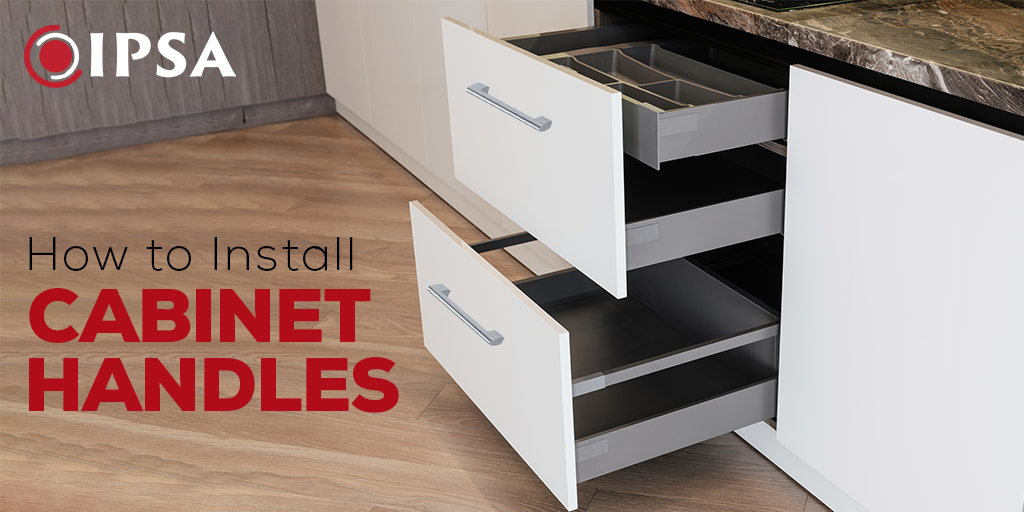When it comes to transforming the look of your kitchen or bathroom, installing new cabinet handles can make a significant difference in both style and functionality. Whether you’re upgrading outdated hardware or installing handles on newly built cabinets, the process is straightforward and budget-friendly. Choosing the right handles not only elevates the aesthetic appeal of your space but also ensures easy access and comfort in everyday use. To get the best quality and design options, consider sourcing your handles from a reputable cabinet handle manufacturer that offers a wide variety of styles to match your home’s décor.
If you’re ready to take on this DIY project, this guide will walk you through the entire process of installing cabinet handles.
The Importance of Choosing the Right Cabinet Handles
It’s essential to recognize the importance of selecting the right cabinet handles. Not only do they contribute to the overall style of your space, but they also affect how functional and easy your cabinets are to use. When choosing handles, consider the style of your cabinets and the finish of your kitchen or bathroom. Handles come in various designs, from sleek, modern pulls to more traditional knobs. Pick something that complements your decor.
Also, ensure that your chosen handles are comfortable to grip and easy to use. Whether you’re opening a kitchen cabinet after cooking or a bathroom vanity, you’ll want a handle that provides a secure, ergonomic grip.
Tools You’ll Need for Installing Cabinet Handles
Installing cabinet handles is a relatively simple project that requires a few essential tools. Gather the following items before starting:
- Tape Measure – To accurately measure the placement of the handles.
- Pencil – To mark the spots where the handles will go.
- Drill – To make the screw holes.
- Screwdriver – For securing the handles in place.
- Level – To ensure the handles are straight and evenly placed.
- Template or Jig (Optional) – A helpful tool for positioning multiple handles consistently.
- Handles – Of course, the cabinet handles themselves.
- Screws – Usually included with the handles, but make sure they’re the right size for your cabinet.
Steps Involved in the Installation of Cabinet Handles
Step-by-step guide is as follows:-
Step 1: Measure and Mark the Placement
The first step to installing cabinet handles is to decide where you want them placed. Typically, cabinet pulls are installed vertically on drawers and horizontally on doors. However, the exact placement depends on your design preferences and the type of cabinet you’re working with.
For drawers:
- Use a tape measure to mark the center of the drawer front. Most handles are placed 2-3 inches from the edge of the drawer for comfortable use.
- Mark the placement with a pencil at the desired height.
For cabinet doors:
- Measure from the top of the door, and place the handles at a comfortable height, typically around 2-3 inches from the edge.
- Make sure the placement is consistent across all doors for a uniform look.
If you’re installing multiple handles on similar cabinets, consider using a template or jig. This tool ensures that each handle is positioned the same way, creating a neat and professional look.
Step 2: Drill the Holes for the Handles
Once you’ve marked the spots for the handles, it’s time to drill the holes for the screws. Double-check that your marks are accurate before drilling, as this step is irreversible.
- Drill Pilot Holes: Using a drill bit slightly smaller than your screws, create pilot holes where you made your marks. This will make it easier for the screws to go in and ensure they don’t damage the surrounding area of the cabinet.
- Drill the Final Holes: Once the pilot holes are drilled, use the appropriate-sized drill bit to create holes large enough for the screws that will secure the handles. For drawer pulls, a 1/8-inch bit is typically sufficient for small screws, but always refer to the size of the screw in the handle kit.
- Safety First: Always wear safety goggles to protect your eyes from dust and debris while drilling.
Step 3: Attach the Handles
Now that you’ve drilled the holes, it’s time to attach the handles.
- Align the Handles: Hold the handle against the cabinet, aligning the holes of the handle with the drilled holes on the cabinet. Make sure the handle is in the position you want before securing it.
- Insert the Screws: Use the screws provided with the handles to secure them to the cabinet. Begin by inserting the screws through the back of the cabinet (or the inside of the drawer) and threading them into the handle. Tighten the screws just enough to hold the handle in place, but don’t over-tighten, as this can crack the cabinet material or strip the screw hole.
- Check the Alignment: Before fully tightening the screws, check that the handle is straight. Make sure everything is properly aligned by using a level.
- Tighten the Screws: Once everything is aligned, tighten the screws using a screwdriver. Be careful not to overtighten, as this can damage the cabinet or the handle.
Step 4: Test the Handles
Once all the handles are attached, it’s time to test them. Open and close your cabinet doors and drawers to make sure the handles are functional and secure. If any of the handles feel loose or wobble, double-check that the screws are tightened properly. By buying from a reliable kitchen cabinet hardware brand, you will get the right product for your door.
Step 5: Make Adjustments as Needed
If you notice any handles aren’t quite aligned, or if something doesn’t feel right, it’s easy to make adjustments. Loosen the screws slightly, adjust the position of the handle, and then retighten the screws.
Tips for Installing Cabinet Handles Like a Pro
- Consider Placement on Different Cabinet Styles: For cabinets with ornate designs, you may want to opt for smaller handles or knobs to avoid overwhelming the look. Conversely, modern cabinets may benefit from larger, more prominent hardware.
- Use a Template for Consistency: If you’re installing handles on multiple cabinets, using a template will help you maintain consistency in the placement of handles across all units.
- Choose Quality Handles: While looks are important, don’t forget about the durability and function of your cabinet handles. Choose handles made from high-quality materials that will last for years to come.
- Work Slowly and Carefully: The key to installing cabinet handles like a pro is patience. Take your time, measure twice, and double-check before drilling. This will ensure your handles are perfectly installed and aligned.
- Upgrade Your Hardware for a Fresh Look: Swapping out old, worn handles for fresh new ones can breathe new life into your cabinets. It’s an easy upgrade that can have a big impact on the overall look and feel of your kitchen or bathroom.
Final Thoughts:
Installing cabinet handles is a simple yet impactful DIY project that can elevate the style and function of your space. By following the steps outlined above and taking your time with each part of the process, you can achieve professional-looking results without the need for an expert. Whether you’re working with cabinets in your kitchen, bathroom, or elsewhere in the home, new handles can make all the difference in creating a polished and cohesive look.
So, gather your tools, choose the perfect cabinet handles, and get started on this satisfying and rewarding project. With just a few hours and some basic supplies, you can give your cabinets a fresh, modern update!
IPSA India is a leading hardware brand known for its high-quality cabinet handles and cabinet hinges. Offering innovative and durable designs, IPSA ensures functionality and style in every product. Our extensive range of premium kitchen hardware solutions adds elegance and practicality to modern kitchen spaces.



